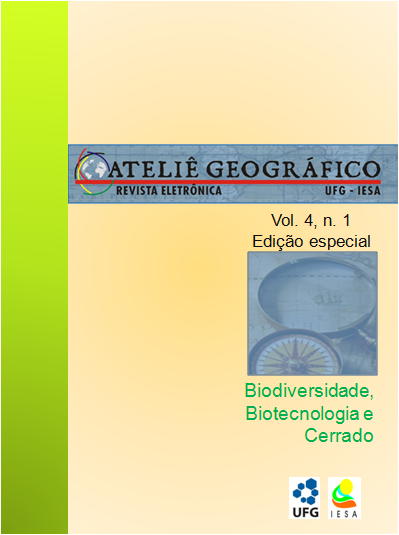EL KARAJA ARUANA-GO Y SUS TERRITORIOS RESTRINGIDOS: bajo la diversidad biológica, la integridad sacudida
DOI:
https://doi.org/10.5216/ag.v4i1.16684Resumen
¿Cuáles son las estrategias de supervivencia de los indios Karajá de Aruanã-GO ante la pérdida de la diversidad biológica en el Cerrado y la fragmentación y la reducción de sus territorios? Este es el tema central en discusión en este artículo. A lo largo de los siglos, el pueblo Karajá ha visto sus tierras tradicionales reducirse a tres áreas fragmentadas y presionadas por la agricultura y el turismo. Con la llegada de los primeros colonos, en el territorio hoy conocido como Goiás, se inició el proceso que desencadenó la reducción, fragmentación y pérdida de los territorios indígenas. Por causa de este proceso, actualmente la fauna y la flora del Cerrado - uno de los elementos básicos para el mantenimiento de la integridad física y cultural de los pueblos indígenas – son una sombra que se desvanece con la deforestación y con otras formas de degradación ambiental que plagan el municipio. Divididos entre la tradición que marca el río Araguaia - como el principal pilar de la cosmología – y el ethos de un municipio urbano que responda a las exigencias del capitalismo global, el pueblo Karaja enfrenta numerosos retos para su supervivencia física y cultural. En razón de esto, el pueblo Karajá ha articulado estrategias para el desarrollo de un nuevo sentido a su producción artesanal y para la utilización de su territorio en un proceso dinámico que ofrezca varias rutas en la búsqueda de los recursos espaciales para la producción de artesanías para el mercado. En esta investigación, la prioridad fue la discusión cualitativa, desarrollada a partir de una rica variedad de recursos metodológicos y teóricos, cuyo objetivo principal consistió en establecer diálogo con los individuos participantes.
Descargas
Descargas
Publicado
Cómo citar
Número
Sección
Licencia
Autores que publicam nesta revista concordam com os seguintes termos:- Autores mantém os direitos autorais e concedem à revista o direito de primeira publicação, com o trabalho simultaneamente licenciado sob a Licença Creative Commons Attribution que permite o compartilhamento do trabalho com reconhecimento da autoria e publicação inicial nesta revista.
- Os autores não serão remunerados pela publicação de trabalhos na Revista Ateliê Geográfico. Além disso, os conteúdos publicados são de inteira e exclusiva responsabilidade de seus autores, ainda que reservado aos editores o direito de proceder a ajustes textuais e de adequação às normas da publicação.
- Autores têm permissão e são estimulados a divulgar seu trabalho online (ex.: em repositórios institucionais ou na sua página pessoal), já que isso pode gerar alterações produtivas, bem como aumentar o impacto e a citação do trabalho publicado (Veja O Efeito do Acesso Livre).


